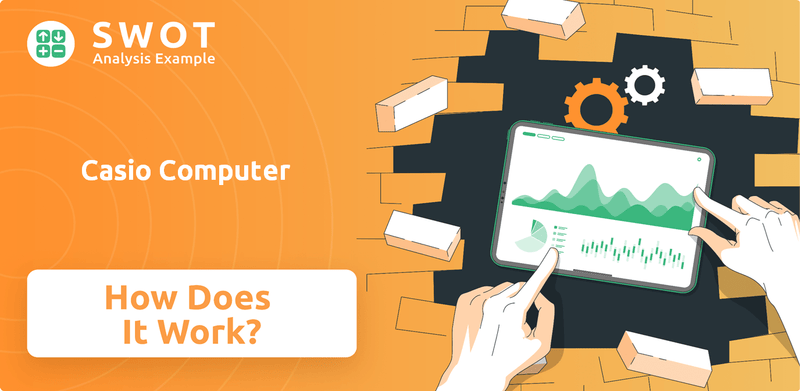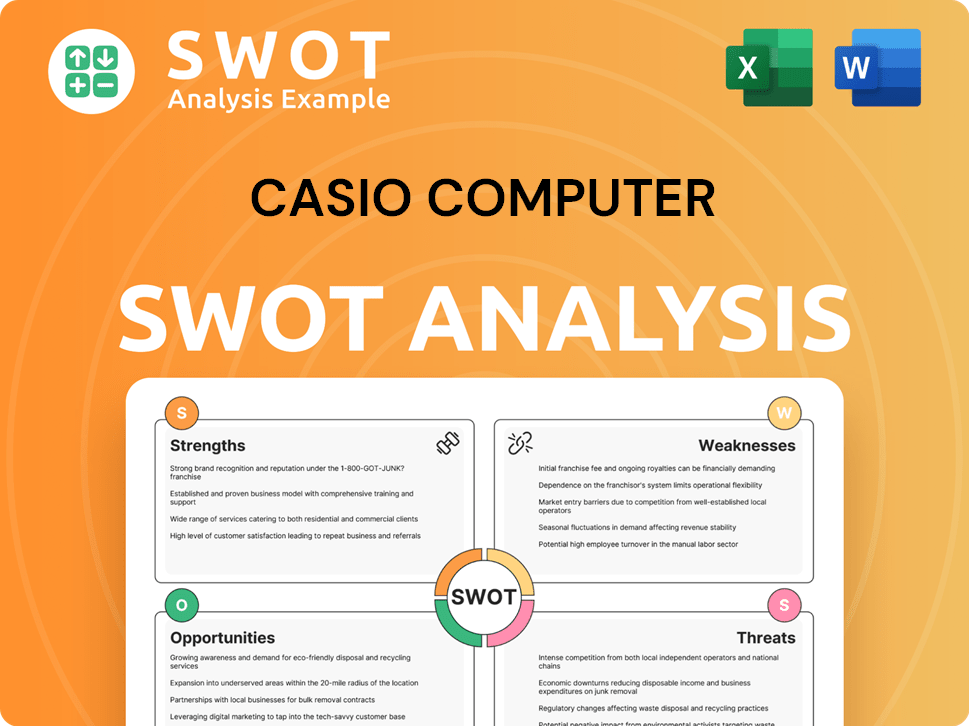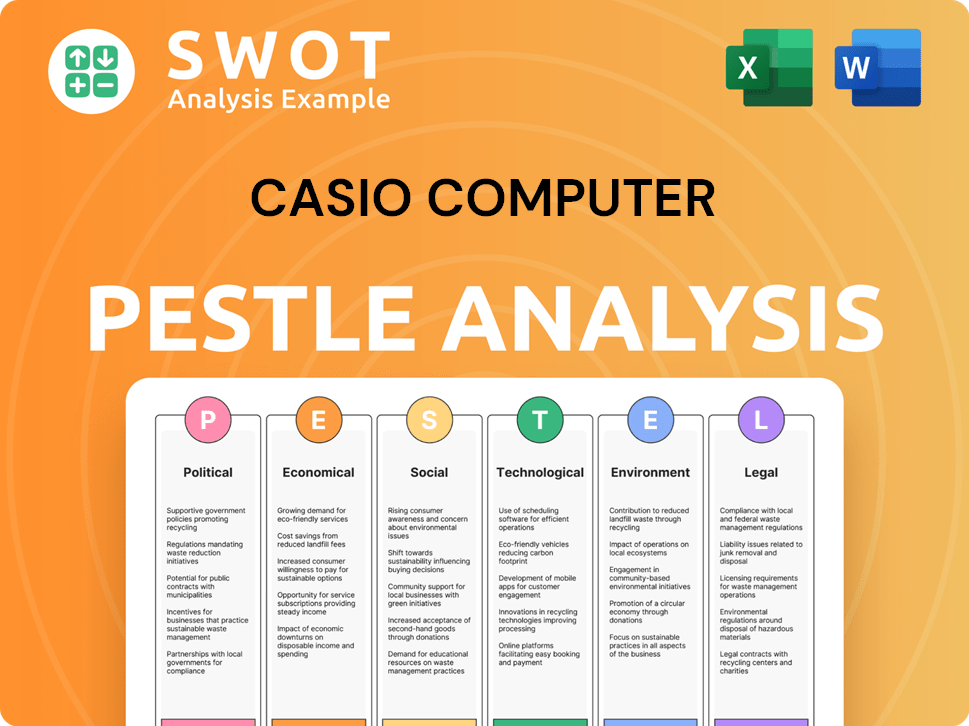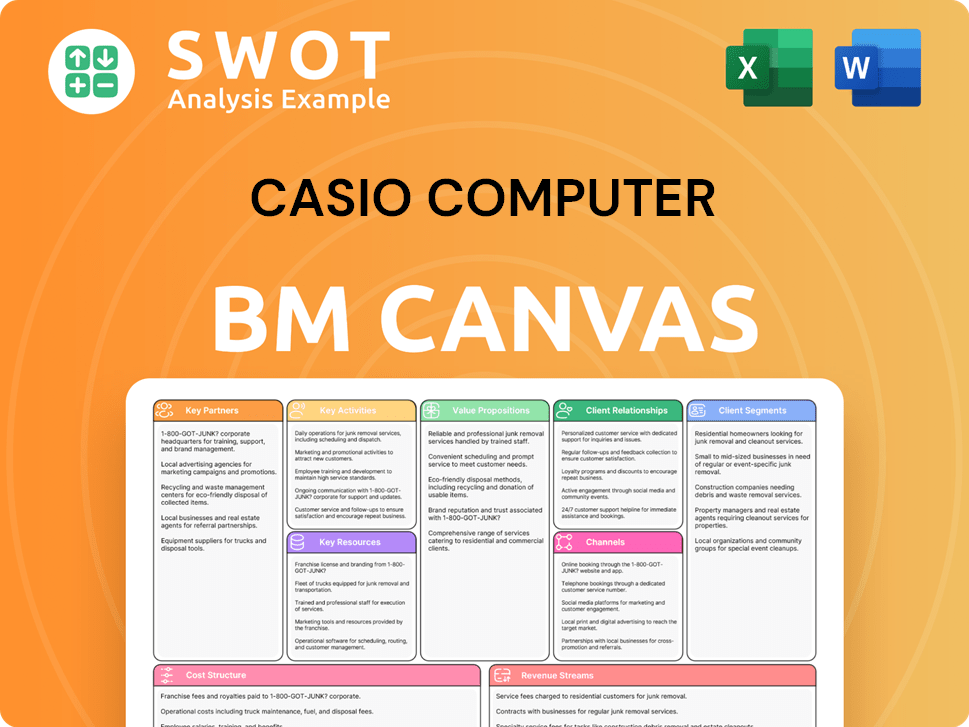Casio Computer Bundle
How Does Casio Computer Company Thrive in a Tech-Driven World?
From revolutionizing personal calculators with the Casio Mini to pioneering digital photography with the QV-10 and creating the indestructible G-Shock, Casio Computer Company has consistently redefined consumer electronics. Its legacy of innovation spans decades, shaping industries and captivating consumers worldwide. But how does this global powerhouse, with its diverse range of Casio Computer SWOT Analysis products, maintain its competitive edge?

This exploration of the Casio business model will unravel the strategies behind its enduring success. We'll examine its core operations, revenue streams, and how Casio manufacturing processes contribute to its global presence. Understanding Casio's history and its adaptation to technological advancements provides valuable insights for anyone interested in the company's financial performance analysis and future outlook.
What Are the Key Operations Driving Casio Computer’s Success?
The core operations of Casio Computer Company revolve around designing, manufacturing, and selling a diverse range of electronic products. This includes everything from watches and calculators to musical instruments and system equipment. The company's business model is built on innovation, creating compact, efficient, and affordable devices for a global market.
Casio operates across the entire product lifecycle, from initial design and development to manufacturing, sales, and after-sales service. A significant portion of its resources is dedicated to research and development, ensuring the company remains at the forefront of technological advancements. Casio's global presence, with manufacturing facilities in Japan, China, and Thailand, supports its efficient supply chain and ability to meet worldwide demand.
Casio differentiates itself by offering niche products at competitive prices, a strategy that has been successful since the launch of the Casio Mini calculator in 1972. Its value proposition centers on providing durable, functional, and innovative products that often set industry standards. For example, the G-Shock series is known for its shock resistance, and its calculators offer advanced features.
Casio offers a wide array of products, including watches, electronic dictionaries, calculators, electronic musical instruments, and system equipment. The company's product range caters to various customer segments, from students and professionals to hobbyists and businesses. This diversified portfolio helps Casio mitigate risks and capitalize on different market opportunities.
Casio has strategically located its manufacturing facilities in Japan, China, and Thailand to optimize its supply chain. This global presence allows for efficient production and distribution of its products. The company's focus on compact and energy-efficient designs also contributes to cost-effective manufacturing processes.
Casio invests heavily in research and development to drive innovation and maintain its competitive edge. In fiscal year 2023, the company spent approximately ¥27.8 billion on R&D, a 6.2% increase from the previous year. This investment supports the development of new technologies and cutting-edge products, ensuring Casio remains at the forefront of the consumer electronics industry.
Casio delivers value to its customers through durable, functional, and innovative products. The company's focus on affordability and niche devices has resonated with consumers worldwide. Casio is also expanding into new areas, such as personal coaching services, leveraging its expertise in wearable devices and sensing technology.
Casio's operational success is built on several key factors, including its ability to innovate, its efficient manufacturing processes, and its strong brand recognition. The company's commitment to R&D ensures it can continually introduce new and improved products. Moreover, Casio's global presence allows it to effectively manage its supply chain and reach customers worldwide.
- Innovation: Continuously developing new technologies and products to meet evolving customer needs.
- Manufacturing Efficiency: Utilizing global production facilities to optimize costs and ensure timely delivery.
- Brand Strength: Maintaining a strong brand reputation for quality, durability, and innovation.
- Market Adaptation: Expanding into new areas like personal coaching services.
For a deeper understanding of Casio's competitive environment, consider exploring the Competitors Landscape of Casio Computer.
Casio Computer SWOT Analysis
- Complete SWOT Breakdown
- Fully Customizable
- Editable in Excel & Word
- Professional Formatting
- Investor-Ready Format

How Does Casio Computer Make Money?
The Casio Computer Company generates revenue through a diversified approach, primarily focusing on three key business segments: Timepieces, Consumer Products, and System Equipment. This strategy allows Casio to capture various market segments and mitigate risks associated with relying on a single product category. The company's financial performance reflects the effectiveness of these revenue streams.
Casio's fiscal year 2023 saw the Timepieces segment, which includes popular brands like G-Shock and Baby-G, as the largest contributor, accounting for 62% of sales. The Consumer Products segment, which includes educational products like calculators and electronic musical instruments, and System Equipment, which includes POS machines and office printers, also play significant roles. This multi-segment approach is a core part of the Casio business model.
For the fiscal year ending March 31, 2025, Casio Computer reported an annual revenue of ¥261.76 billion, marking a decrease of 2.63% from the previous year. In the quarter ending March 31, 2025, revenue was ¥65.98 billion, down 2.31%. This indicates a need for strategic adjustments to boost revenue, which the company is addressing through various initiatives.
Casio employs several monetization strategies to maximize revenue across its product lines. A significant aspect of this is software licensing, which has seen growth, particularly with calculator simulators for educators and commercial licensing agreements. The company is also focused on expanding its global presence, aiming to increase its overseas sales ratio to 60% of total sales by 2025, up from the current 55%. For more insights, explore the Marketing Strategy of Casio Computer.
- Timepieces: This segment, which includes the iconic G-Shock and Baby-G watches, generated approximately ¥107.5 billion in revenue in fiscal year 2023, representing 29.8% of total revenue.
- Consumer Products: This segment includes educational products like calculators, electronic dictionaries, and electronic musical instruments.
- System Equipment: This segment includes POS machines and office printers.
- Licensing: Licensing revenue reached approximately ¥4.5 billion (around $40 million) for agreements tied to its patented technologies in watchmaking and electronic devices.
Casio Computer PESTLE Analysis
- Covers All 6 PESTLE Categories
- No Research Needed – Save Hours of Work
- Built by Experts, Trusted by Consultants
- Instant Download, Ready to Use
- 100% Editable, Fully Customizable

Which Strategic Decisions Have Shaped Casio Computer’s Business Model?
The journey of the Casio Computer Company, a global leader in consumer electronics, is marked by significant milestones. From pioneering calculators to iconic timepieces and innovative digital cameras, Casio has consistently demonstrated its ability to adapt and innovate. This evolution showcases its resilience and strategic foresight in navigating the dynamic consumer electronics market. A deeper understanding of Casio's history reveals the strategic moves that have shaped its competitive edge.
Casio's strategic moves, from product diversification to market restructuring, reflect its adaptability. The company has responded to market shifts by exiting unprofitable ventures and focusing on core strengths. This includes streamlining its product lines and embracing technological advancements to maintain its relevance. This proactive approach has been crucial in sustaining its market position and driving future growth. The company's financial performance highlights its ability to adapt to market challenges.
Casio's competitive edge stems from its strong brand recognition, particularly with products like G-Shock, and its commitment to continuous innovation. The company's ability to integrate cutting-edge technology, such as AI and IoT, into its products, is a key driver of its success. Furthermore, its strategic shift towards community building and direct-to-consumer sales via its e-commerce platform demonstrates its forward-thinking approach to business. For more insights, check out the Growth Strategy of Casio Computer.
Casio's history includes several key milestones. The Casio Mini calculator launch in 1972 and the G-Shock wristwatch in 1983 were pivotal. The 1995 release of the QV-10, the world's first digital camera with an LCD display, further showcased innovation.
Casio has made several strategic moves. This includes restructuring unprofitable businesses, such as exiting the digital camera business in 2018 and the projector business in 2020. In February 2025, Casio announced it would stop developing new models of electronic dictionaries.
Casio's competitive advantages include strong brand recognition, particularly with G-Shock, and proprietary technology. The company is adapting to new trends by integrating advanced technology such as artificial intelligence and IoT capabilities into its products. Casio is also shifting its G-Shock business model to focus on building fan communities.
In 2023, Casio launched over 50 new products, contributing ¥10 billion (approximately $75 million) to total revenue in fiscal year 2023. The company is streamlining its electronic musical instrument business by halving its product lineup. This demonstrates the company's ability to adapt to changing market demands.
Casio has shown a remarkable ability to adapt to changing market conditions. The company has strategically exited certain business areas while focusing on innovation and core strengths. This approach has helped Casio maintain its competitive edge.
- Exiting the digital camera business in 2018 reflects a strategic shift.
- Focus on integrating advanced technology like AI and IoT into products.
- Streamlining product lines to meet evolving consumer demands.
- Building fan communities and direct-to-consumer sales via e-commerce.
Casio Computer Business Model Canvas
- Complete 9-Block Business Model Canvas
- Effortlessly Communicate Your Business Strategy
- Investor-Ready BMC Format
- 100% Editable and Customizable
- Clear and Structured Layout

How Is Casio Computer Positioning Itself for Continued Success?
The industry position of Casio Computer Company is solid, though not dominant, within the consumer electronics sector. It competes with major players like Samsung, Canon, and Sony. While the G-Shock brand holds a strong niche in the affordable sports watch market, the company currently lacks a major revenue driver beyond watches and calculators. Casio aims to grow its market share in Asia, achieving a 15% increase in 2023.
Casio's risks include competition from smartphones, currency fluctuations (especially the Euro and Chinese Yuan), and declining demand for products like electronic dictionaries. A ransomware attack in October 2024 compromised Casio's servers, leading to the leakage of internal documents and highlighting cybersecurity risks.
Casio competes in the consumer electronics market against major brands. The G-Shock brand is a key player in the sports watch segment. The company is working on expanding its market share in Asia.
The substitution of Casio products by smartphones poses a significant risk. Currency fluctuations, particularly the Euro and Chinese Yuan, impact profitability. Declining demand for certain product categories, such as electronic dictionaries, also presents challenges.
Casio's strategic plan focuses on structural reform and strengthening its profit base. The company aims to revitalize core businesses and create new ones. Casio is also exploring new ventures like mental wellness.
Casio plans to return core businesses like timepieces and educational scientific calculators to growth. The company is focused on creating new businesses using existing assets. Casio is also planning to strengthen its management foundation.
Casio's long-term strategy emphasizes innovation and leveraging its intellectual property. The company is aiming to create new lifestyles and expand its revenue streams through proactive global strategies and fan community engagement. For more detailed insights into Casio's growth strategy, you can read Growth Strategy of Casio Computer.
- Focus on returning core businesses to growth.
- Exploring new business opportunities such as mental wellness.
- Leveraging intellectual property through licensing.
- Proactive global strategies and fan community engagement.
Casio Computer Porter's Five Forces Analysis
- Covers All 5 Competitive Forces in Detail
- Structured for Consultants, Students, and Founders
- 100% Editable in Microsoft Word & Excel
- Instant Digital Download – Use Immediately
- Compatible with Mac & PC – Fully Unlocked

Related Blogs
- What are Mission Vision & Core Values of Casio Computer Company?
- What is Competitive Landscape of Casio Computer Company?
- What is Growth Strategy and Future Prospects of Casio Computer Company?
- What is Sales and Marketing Strategy of Casio Computer Company?
- What is Brief History of Casio Computer Company?
- Who Owns Casio Computer Company?
- What is Customer Demographics and Target Market of Casio Computer Company?
Disclaimer
All information, articles, and product details provided on this website are for general informational and educational purposes only. We do not claim any ownership over, nor do we intend to infringe upon, any trademarks, copyrights, logos, brand names, or other intellectual property mentioned or depicted on this site. Such intellectual property remains the property of its respective owners, and any references here are made solely for identification or informational purposes, without implying any affiliation, endorsement, or partnership.
We make no representations or warranties, express or implied, regarding the accuracy, completeness, or suitability of any content or products presented. Nothing on this website should be construed as legal, tax, investment, financial, medical, or other professional advice. In addition, no part of this site—including articles or product references—constitutes a solicitation, recommendation, endorsement, advertisement, or offer to buy or sell any securities, franchises, or other financial instruments, particularly in jurisdictions where such activity would be unlawful.
All content is of a general nature and may not address the specific circumstances of any individual or entity. It is not a substitute for professional advice or services. Any actions you take based on the information provided here are strictly at your own risk. You accept full responsibility for any decisions or outcomes arising from your use of this website and agree to release us from any liability in connection with your use of, or reliance upon, the content or products found herein.